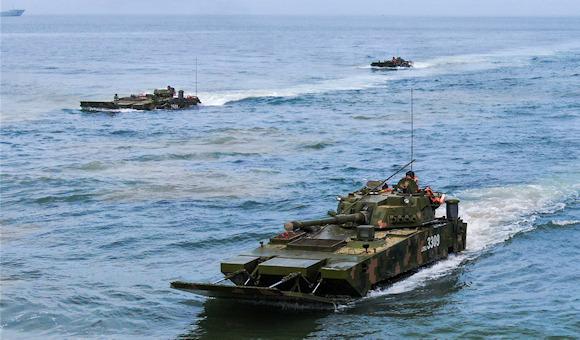In these hours the fighters of the PLAAF (People's Liberation Army Air Force) continue to fly over the skies of Taiwan. Of course, the Air Force flyovers and Chinese naval exercises at the edge of Taipei's territorial waters represent more provocations than anything else. However, they are a not so veiled signal of Beijing's real intentions.
The fact that the Chinese are standing is certainly an indication of this requisitioning civilian ferries (ships Roll-on / Roll-off) of large dimensions to allow them to participate in amphibious exercises. A Maxar Techonolgies satellite photo on August 31, taken by the United States Naval Institute, shows one of these civil boats with the stern ramp lowered into the water and on the beach a row of amphibious armored vehicles ready to be boarded to participate in the exercise.
Analyst Tom Shugart told USNI News that he identified the commercial ferry as the Bo Hai Heng Tong. She is a 15.000-ton displacement general-purpose cargo and ferry ship. She was more than 1.500 km off her regular route in the Bohai Sea, and was only one of seven similar civilian ferries participating in the amphibious exercise.
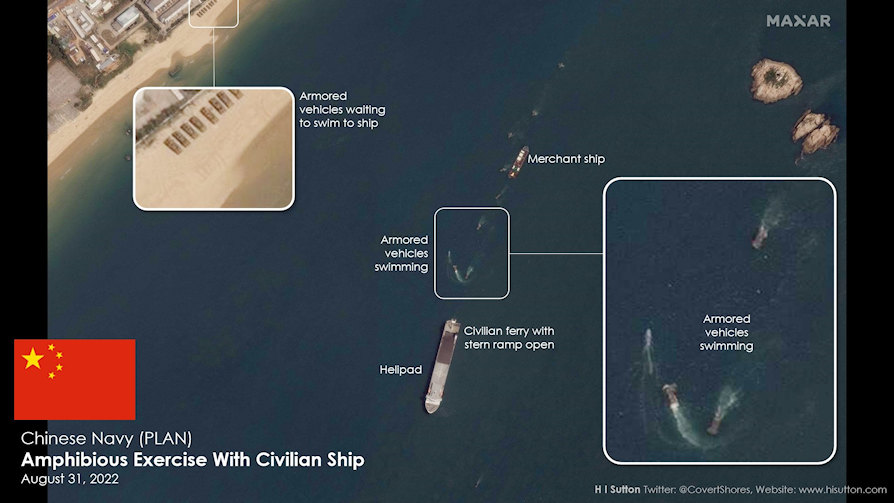
All three ferries together constitute essential naval carriers in order to fuel a possible invasion of Taiwan, as each ship carries three times more vehicles than comparable Landing Docks (LPDs) of the class San Antonio, under the US Navy.
Shugart also added that "An LHA or LPD is a lot of cubic meters for Marine departments that can operate for weeks or months at sea. That's a lot of wasted space. if the only thing you do is a quick trip across the strait".
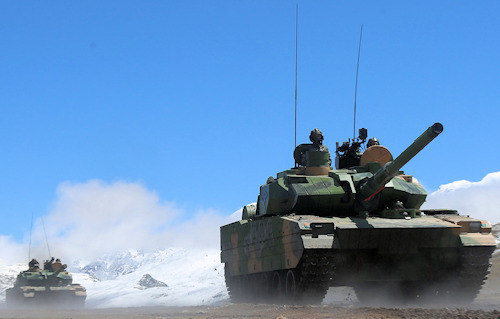
In fact, the use of a civilian ferry would only be functional to transport vehicles from the Chinese coast to the place chosen for landing on the island of Taiwan, such as the ZLT-11 armored vehicles and the ZTQ-15 light tanks (photo).
On the occasion of the recent visit of the Speaker of the United States House, Nancy Pelosi, to Taiwan, China gave an important demonstration of its fighting skills.
The planes have flown the skies. Warships have sailed the oceans. Troops and tanks rushed to the beaches to practice.
But, muted and in the background, three huge commercial ferries have strangely deviated from course to support these maneuvers.
Now we know why.
While they are not visible in the propaganda show, they were needed to produce it, thanks to their inherent carrying capacity, essential to fuel a possible invasion of Taiwan.
It is also true that the PLA's dedicated troop transport force is unexpectedly small. Even if it is growing rapidly.
Last year, the first Type 075 amphibious assault ship (LHD) was launched (photo). Two more are close to entering service in the People's Liberation Army Navy (PLAN).
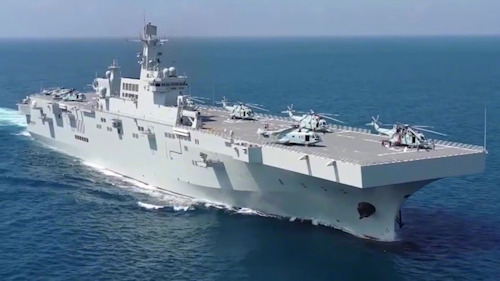
But these and other small-displacement amphibious units in the line are simply too few to deploy enough troops and tanks to conquer Taiwan's well-defended beaches.
The lack of this capability has often been used to argue that Taiwan is safe. At the moment.
But what if China already had a large-scale, military-grade shipping capacity ready to go?
Would this put Taiwan at imminent risk of President Xi's stated goal of completing the Communist Party's "unfinished business" in the 1949 Civil War and assimilating the Republic of China's last outpost?
The ships Roll / on, Roll / off (RO-RO) were first tested by the Royal Navy after the emergency evacuation of Dunkirk in 1940 demonstrated the need to load vehicles as quickly as possible. The solution was to install a retractable ramp at the bow and / or stern of a cargo ship, so that it could get on and off.
The idea was quickly adopted by ferry operators around the world to transport trucks and cars over unpaved waterways.
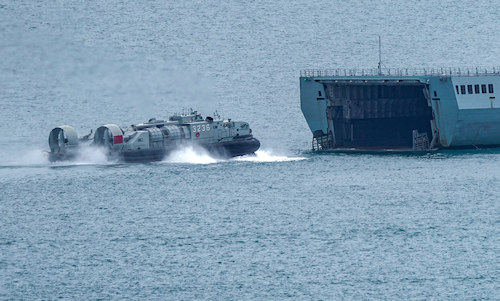 What differentiates a military amphibious assault ship from a commercial RO-RO is the ability to open the ramp at sea. This allows any craft, from small boats and hovercraft to landing craft and tanks, to glide back and forth between the ship and the sea.
What differentiates a military amphibious assault ship from a commercial RO-RO is the ability to open the ramp at sea. This allows any craft, from small boats and hovercraft to landing craft and tanks, to glide back and forth between the ship and the sea.
A Naval War College professor of maritime studies, Conor Kennedy, pointed out that China's new large RO-RO ships have strengthened their ramps beyond mere civilian needs. The videos showed the support beams and hydraulic systems needed to cope with the lateral forces produced by the interaction with the waves. This would allow the ramp to be lowered directly into the water to load and unload heavy vehicles such as tracked and wheeled armored vehicles.
The first evidence of their use in military operations came in 2020, when the 15.000-ton civilian ferry Bang Chui Dao was seen during a PLA assault exercise on the beach. It typically carries 1.200 passengers with 825 m² of vehicle parking. Although he was not directly observed attending, Chinese footage of the event showed the release of landing vehicles from an unprecedented ramp.
Kennedy argued that the RO-RO could have carried up to 50 amphibious assault vehicles, enough for an entire battalion of mechanized infantry. And he adds that 62 other Chinese commercial ferries may also have been adapted for similar military use.
 State-controlled Chinese broadcaster CCTV7 showed another RO-RO commercial ferry, lo Zhong Hua Fu Zing, with tanks filling its 20.000 m² bay. Video was later removed (frame).
State-controlled Chinese broadcaster CCTV7 showed another RO-RO commercial ferry, lo Zhong Hua Fu Zing, with tanks filling its 20.000 m² bay. Video was later removed (frame).
This massive ship would likely be part of a second wave of assault forces, transporting its tanks directly to a pier or beach occupied by the first wave of landing.
Lastly it is good to remember that, unlike the Ukrainian state, Taiwan is not recognized by most of the nations (including the United States).
The question is therefore: when the island of Formosa is invaded by the People's Republic of China, will the international community have the same reaction towards the so-called “world factory” that it had with the Russian Federation?
Images: Ministry of National Defense of the People's Republic of China / Twitter / Weibo

